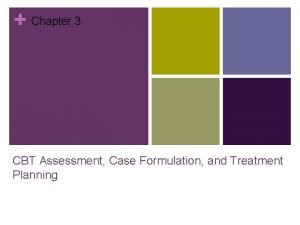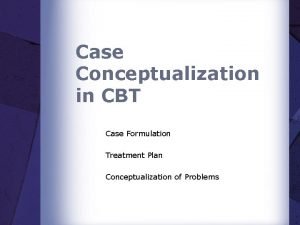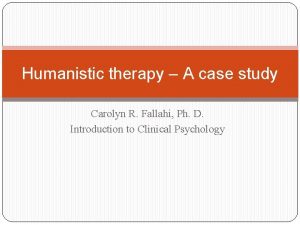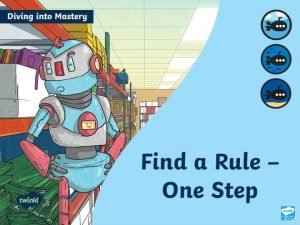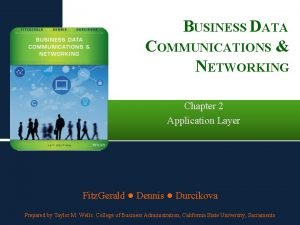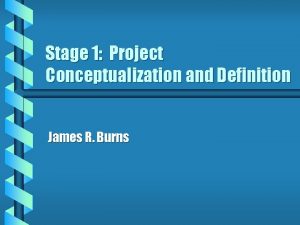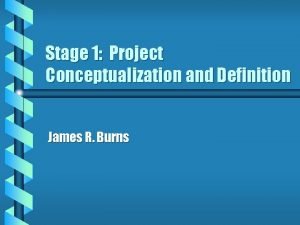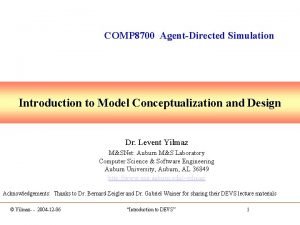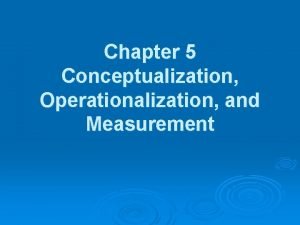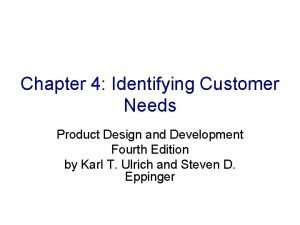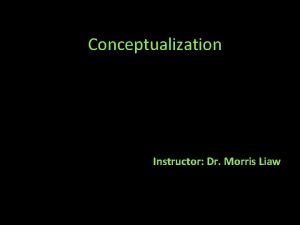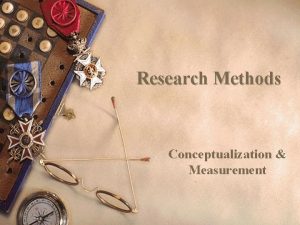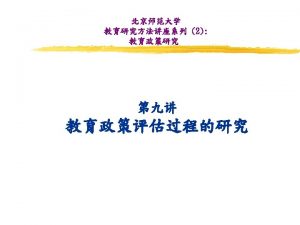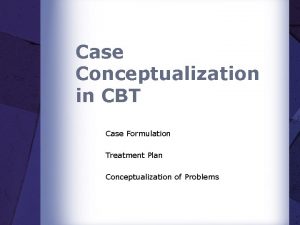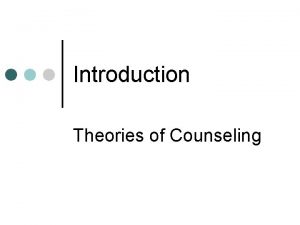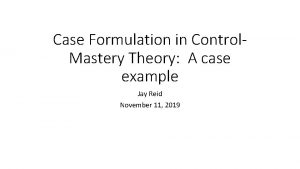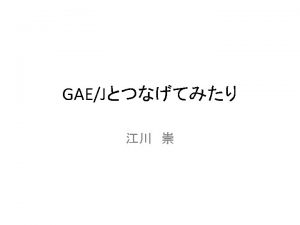Control Mastery Case Conceptualization Making the Client into












- Slides: 12

Control Mastery Case Conceptualization: Making the Client into the Protagonist Jay Reid, MS, LPCC November 4, 2019

Where clients start Child’s ability to fully be themselves Where clients want to go Therapist’s willingness to support client Parents’ willingness to take care of child Control-Mastery Theory Overview Client’s ability to fully be themselves

5 Diagnostic Questions to Conceptualize a Case 1. What are client’s conscious and unconscious adaptive goals for coming to therapy? 2. What’s getting in the way of achieving these goals? (i. e. Pathogenic Beliefs (PB)) 3. Key traumas that gave rise to PB’s? 4. How’s the client going to test these PB’s out with therapist? 5. What kinds of interventions/attitudes would be helpful?

1. What are client’s conscious and unconscious adaptive goals for coming to therapy? • CMT holds that all clients are motivated to pursue healthy developmental goals that had to be sacrificed earlier in life because they concluded it was not safe to do so • The client’s motivation to achieve these goals is called ’the plan’ • Often the client’s plan is unconscious because they do not feel it is safe enough to know consciously • It’s the client’s call as to what his/her plan is and the sequence of plans to pursue • It’s therapist’s job to discern the client’s current plan and make interventions and/or express attitudes that are ‘pro-plan’

2. What’s getting in the way of achieving these goals? (i. e. Pathogenic Beliefs) • There’s a reason why clients can’t just enact their plan on their own…Pathogenic Beliefs about why it’s not interpersonally safe to do so. • PB’s are ways of being the client had to adopt that prevent him/her from being fully themselves in order to maintain a needed relational tie. • Such PB’s are made because they increased the likelihood that a Parental figure would take care of them • Kids’ existential safety depends on their Parents’ willingness to take care of them • Any of the kid’s actions or feeling-states that makes their Parents less likely to take care of them will feel unsafe • To the degree that such healthy behaviors seem to diminish their Parent’s good will towards them, they will surrender these behaviors in favor of PB’s that re-establish their Parents’ willingness to take care of them • It’s not all-or-none, as the child tries to constantly weigh the safety-to-danger ratio of each Belief, trying to fashion the best compromise for the self and the tie to the Parent as is possible.

Two kinds of Pathogenic Beliefs • Compliance: Going along with a compromised parent’s view of you so that they remain intact and willing to take care of you • In healthy families, kids are allowed to think negatively about their parents, because their parents can stand it, discuss it and repair it. • For people in dysfunctional families, it was forbidden to think negatively about the parent because that can trigger the parent to behave really badly. • So, the solution is to direct all fault and blame towards the self and keep the dysfunctional parent clean in the child’s mind. • “It’s better to be a sinner in a world ruled by God than live in a world with no God. ” • Identification: If you're angry at the parents for a problem they have, but it’s not safe to know about this anger, then you develop the same problem so you have less reason to be mad at them.

The role of guilt in Pathogenic Beliefs • Once a kid has determined that he risks his Parents’ goodwill towards him if he is fully himself, he needs a set of internal alarms to keep him from doing what comes naturally • Enter guilt! • In a dysfunctional family, kids often feel: • responsible for their parent’s wellbeing, • convinced that their actions can make-or-break that parent, and • self-blaming if and when their actions or attitudes seem to hurt that parent. • Guilt results when such kids separate from or outdo the problematic parent • Guilt keeps the child from doing what threatens their tie to the parent

3. Key traumas that gave rise to PB’s? • Trauma is relational in nature: these are specific experiences or contexts that forced the child to abandon healthy developmental goals in order to maintain their ties to a parental figure • These are the moments they learned it was dangerous to fully be themselves with their parents • A parent’s attitude – even without overt action – can be a key trauma

4. How’s the client going to test these PB’s out with therapist? • The client’s plan motivates her to find out if therapist is safer than her parents were • Specifically, will therapist traumatize her for pursuing her healthy developmental goal? • These tests are largely unconscious and spring from the client’s attempt to create a relationship with therapist that will offer her the conditions of safety required to pursue her goals • Two objectives to tests: 1. Will therapist support the client’s goals? 2. Does therapist possess qualities that the client lacks and would like to have?

Two types of tests: Protection vs. Autonomy Tests • In protection tests, clients were often emotionally and/or physically attacked by their Parents – usually against a backdrop of emotional neglect. • The client may test out the PB that she is undeserving of care and protection by failing to show up for appointments because she assumes it does not matter to therapist • In autonomy tests, client’s healthy strivings for independence were experienced as threatening to her Parents • The client may test out the PB that she cannot be separate from therapist by missing appointments to determine whether this is upsetting to therapist.

Sample Diagnostic Plan Formulation What are client’s conscious and What’s getting in the way of unconscious adaptive goals for achieving these goals? coming to Tx? Pathogenic Beliefs (PB’s) Key traumas that gave rise to PB’s? What kinds of How’s the client going to test the interventions/attitudes would be PB’s out with therapist? helpful to them?

References • Lucid explanation of Unconscious Guilt and how it functions to hold PB’s in place: http: //sfprg. org/control_mastery/docs/Bush 1989. pdf • Overview of CMT: http: //sfprg. org/control_mastery/docs/Rappoport 1996. pdf • Case example of CMT in action: http: //sfprg. org/control_mastery/docs/Silberschatz 2008. pdf • Working with PB’s stemming from self-absorbed parents: http: //sfprg. org/control_mastery/docs/Rappoport 2005. pdf • Best book on the topic: Transformative Relationships by Silberschatz, et. al (2005)
 Cbt assessment example
Cbt assessment example Case conceptualization cbt example
Case conceptualization cbt example Carl rogers case study
Carl rogers case study Diving into mastery
Diving into mastery Best worst and average case
Best worst and average case Thin client vs zero client
Thin client vs zero client Client léger client lourd
Client léger client lourd Application layer
Application layer Project conceptualization stages
Project conceptualization stages Conceptualization of project
Conceptualization of project Model conceptualization in simulation
Model conceptualization in simulation ø meaning measurement
ø meaning measurement Customer needs identification process
Customer needs identification process
